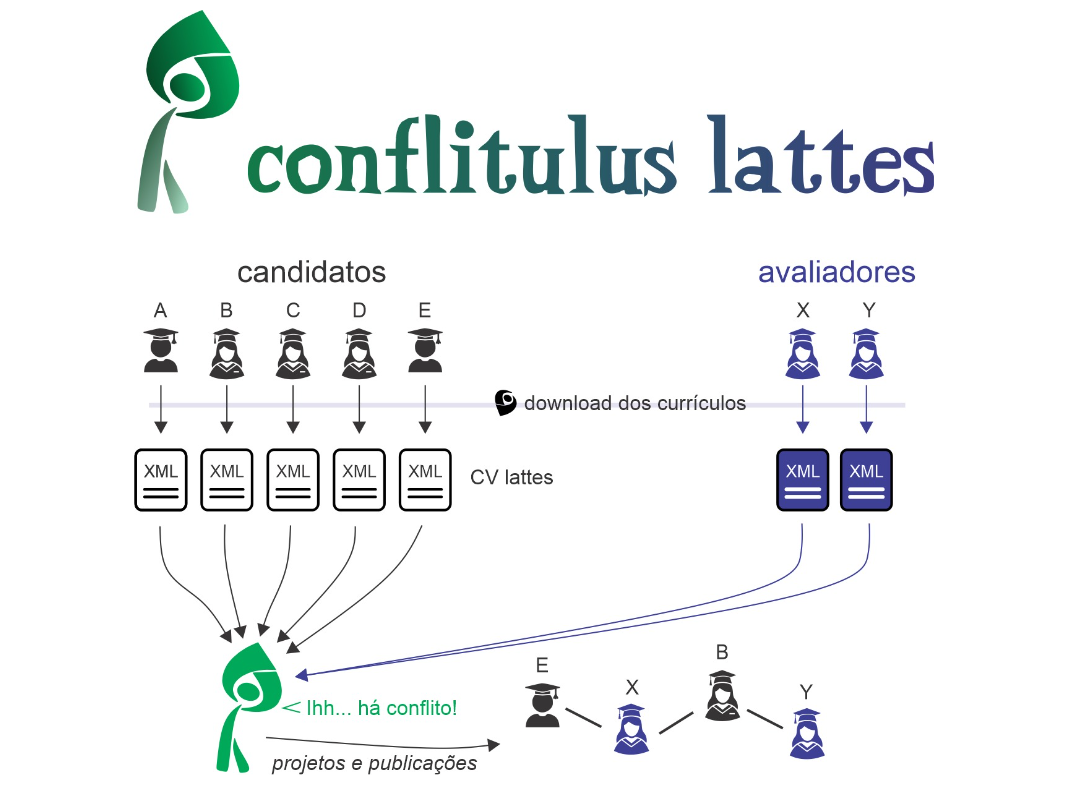

Users can upload and analyze multiple Lattes CVs of candidates and reviewers, quickly identify common co-authorships and collaborations, and manage reports of potential conflicts of interest (image: reproduction)
Developed by a laboratory associated with the Center for Research in Inflammatory Diseases, “Conflitulus Lattes” – named after the Brazilian system of information on science and technology – helps avoid conflicts of interest in review panels.
Developed by a laboratory associated with the Center for Research in Inflammatory Diseases, “Conflitulus Lattes” – named after the Brazilian system of information on science and technology – helps avoid conflicts of interest in review panels.

Users can upload and analyze multiple Lattes CVs of candidates and reviewers, quickly identify common co-authorships and collaborations, and manage reports of potential conflicts of interest (image: reproduction)
Agência FAPESP – The Computational Systems Biology Laboratory (CSBL) has developed Conflitulus Lattes, a tool that aims to avoid conflicts of interest in master’s and doctoral committees by checking articles and projects in common between the CVs of candidates and reviewers within the Lattes platform, the system created by the Brazilian government that integrates databases of curricula, research groups, and higher education institutions.
The CSBL is associated with the Center for Research in Inflammatory Diseases (CRID), a FAPESP Research, Innovation, and Dissemination Center (RIDC) based at the Ribeirão Preto Medical School of the University of São Paulo (FMRP-USP).
The tool was designed by Helder Nakaya, senior researcher at Albert Einstein Jewish Brazilian Hospital (HIAE) and leader of the CSBL. The platform provides an initial screening of potential conflicts of interest, facilitating the analysis of professional and collaborative relationships between participants.
According to Nakaya, Conflitulus Lattes can help users of the Lattes platform save a lot of time. “We included a counter of hours saved each time the tool was run. We estimate that cross-referencing dozens of CVs can save up to ten hours of work, sometimes much more,” the researcher told Agência FAPESP.
Anyone interested can use the tool for free. There is a login and registration approval system. Users can upload and analyze multiple Lattes CVs of candidates and reviewers, quickly identify common co-authorships and collaborations, and manage reports of potential conflicts of interest.
The idea for Conflitulus Lattes came from Nakaya’s personal experience: “I’ve helped organize a few panels and I’ve always seen the enormous effort that goes into checking for conflicts of interest between candidates and reviewers. The ‘last straw’ for me to take action was an invitation I received to sit on a selection committee for the Oswaldo Cruz Foundation. In the invitation, even before the invitation was made official, I was asked if I had published with any of the 26 candidates. To do this, I had to go through the Lattes CV files of 26 candidates. It’s very difficult to know whether or not I was in the same article with any of the candidates, especially considering that there are articles with more than 20 authors,” he says.
The solution was to create a computer code that cross-referenced the information on the researcher’s CV with the 26 files he had received. “Since my lab is used to creating user-friendly online computer tools, I decided to turn this into something useful for other people. I invited my former Ph.D. student Deney Araújo, who is CEO of a database integration startup (D2DNA.com), to help ‘cross-reference’ the files; a Ph.D. student from USP, Juan Carlo, to extract the data from a Lattes CV; and a former Ph.D. student and now a visiting researcher at HIAE, Jeevan Giddaluru, to create the page that users use to run the program,” he explains.
The platform was built using the Python programming language to read the XML file exported from Lattes and save the items in a table containing each person’s publication and project information. “We then used the D2DNA technology we developed to convert the data into DNA sequences and then cross-reference them using BLAST. We visualize the results on the page using JavaScript. There is no database, as the data are extracted from the files that users use to cross-reference their CVs,” adds the researcher.
Conflitulus Lattes has already registered nearly 2,000 people from all over Brazil and has received praise. “When I launched the tool, I received a lot of praise and thanks from various university directors, pro-rectors, and professors who were about to organize competitions,” Nakaya points out.
Republish
The Agency FAPESP licenses news via Creative Commons (CC-BY-NC-ND) so that they can be republished free of charge and in a simple way by other digital or printed vehicles. Agência FAPESP must be credited as the source of the content being republished and the name of the reporter (if any) must be attributed. Using the HMTL button below allows compliance with these rules, detailed in Digital Republishing Policy FAPESP.





